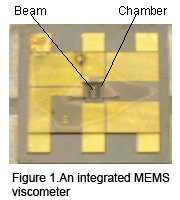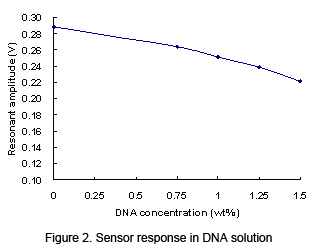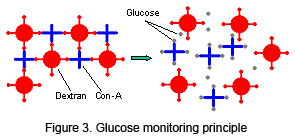| Welcome | People | Research | Presentations | Publications | Facilities | Links |
|---|
|
|
|
|
|
> MEMS Calorimetry |
MEMS Viscometers with Integrated Microfluidics

![]()
We are developing integrated MEMS sensors for measuring the viscosity and viscoelasticity of biomolecular solutions.
An active vibrational element (e.g., a magnetically actuated flexible beam) and temperature control elements (i.e., resistive heaters and temperature sensors) are integrated with a microfluidic chamber for viscosity measurement and microchannels for sample and reagent handling (Figure 1).
When the flexible beam vibrates in a biomolecular solution, dissipation of vibrational energy occurs due to viscous damping.
The damping is a function of the liquid viscosity and is manifested by the beamí»s vibrational characteristics (Figure 2).
Thus, vibration measurements allow the determination of the damping coefficient and biomolecular viscosity.
The device is designed to have features appropriate for biological macromolecules, such as small chamber volumes and low operating frequencies.
The use of low vibration frequencies (ranging from several Hz to 10's of kHz) is critically important as biomolecules typically have large relaxation times, and incorporation of integrated temperature control ensures that measurements appropriately reflect the generally significant temperature dependence of viscosity.

![]() We are currently applying our prototype MEMS viscometers to measurement of glucose.
This approach would eventually lead to integrated miniature sensors that can be implanted in the human body for continuous monitoring of glucose.
Here the microfluidic viscometric chamber is filled with a solution consisting of Dextran, a polymer with terminal glucose residues, and Concanavalin A (Con-A), a specific glucose-binding protein.
The Dextran molecules are crosslinked into a gel-like structure because of the affinity binding of Con-A to the glucose residues, resulting in a highly viscous solution.
When free glucose is added to the solution, the competition between free and polymer-bound glucose weakens the affinity-induced crosslinking of the Dextran, and the solution becomes significantly less viscous.
Thus, measurement of the solution viscosity allows quantitative determination of the free glucose.
We are currently applying our prototype MEMS viscometers to measurement of glucose.
This approach would eventually lead to integrated miniature sensors that can be implanted in the human body for continuous monitoring of glucose.
Here the microfluidic viscometric chamber is filled with a solution consisting of Dextran, a polymer with terminal glucose residues, and Concanavalin A (Con-A), a specific glucose-binding protein.
The Dextran molecules are crosslinked into a gel-like structure because of the affinity binding of Con-A to the glucose residues, resulting in a highly viscous solution.
When free glucose is added to the solution, the competition between free and polymer-bound glucose weakens the affinity-induced crosslinking of the Dextran, and the solution becomes significantly less viscous.
Thus, measurement of the solution viscosity allows quantitative determination of the free glucose.

![]() We are also applying MEMS-based viscometry to characterize the binding of DNA duplexes with small molecules (ligands).
For example, intercalation is a DNA binding mode in which a ligand is inserted between adjacent base pairs, results in a substantial change in DNA structure, and causes lengthening, stiffening and unwinding of the DNA duplex.
These changes result in a pronounced increase in the viscosity of DNA solution, which can be measured by the integrated MEMS viscometer.
We are also applying MEMS-based viscometry to characterize the binding of DNA duplexes with small molecules (ligands).
For example, intercalation is a DNA binding mode in which a ligand is inserted between adjacent base pairs, results in a substantial change in DNA structure, and causes lengthening, stiffening and unwinding of the DNA duplex.
These changes result in a pronounced increase in the viscosity of DNA solution, which can be measured by the integrated MEMS viscometer.
Dr. Jonathan B. Chaires (Formerly at Univ. of Mississippi, now at Univ. of Louisville)
Dr. Qian Wang (Department of Chemistry and Biochemistry, Univ. of South Carolina)
Researchers
Yongjun (Jay) Zhao , Postdoctoral Scholar (ME)
Robert Giacomantonio, Undergraduate Student (ME/BME)